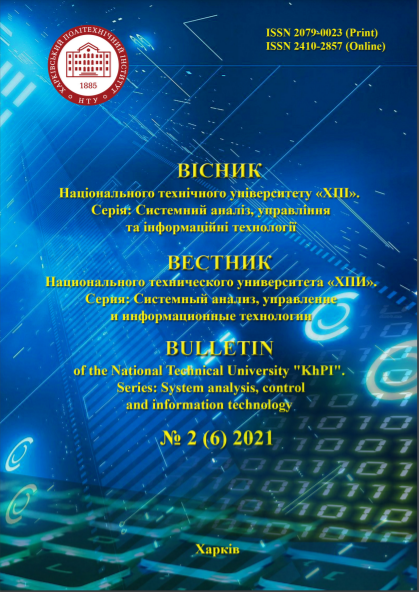METRICS OF VIRTUAL PROMOTION OF A PRODUCT
DOI:
https://doi.org/10.20998/2079-0023.2021.02.04Keywords:
semantic kernel, search engine optimization, conversionAbstract
An approach to the mathematical description of the criterion for the effectiveness of a new object of research – virtual promotion is presented in the
paper. The emergence of this new object of research is connected, on the one hand, with the classical theory of marketing, and on the other with
modern Internet technologies. Marketing is based on the 4P principle: product, price, location and promotion. Promotion is a component of this
principle. But in modern conditions, this phenomenon is changing under the influence of the Internet. Now this 4P component is becoming a fully
virtual instrument. The traditional scheme of promotion functioning is as follows. A message is created to a potential buyer and the delivery channel of
this message undergoes a change. It is based on the principle: money – goods – money. While the new sales scheme is described by the scheme: we
attract a client, make money on a client, we spend money. In the new scheme, we deal with product knowledge in the form of the so-called semantic
core of web content. Knowledge describes for a potential client how a given product can cover his need for something. Using the logistic principles of
the transfer of goods, this semantic core is loaded into the specified Internet nodes. That is, virtual promotion is formed as two channels: logistics and
marketing. The first one performs three operations: concentration, formatting and distribution of semantic cores on the Internet. The second manages
this process, forming a virtual promotion map. This map is a graph of Internet nodes. It is required to define such a tree of Internet nodes so that virtual
promotion has maximum efficiency. The paper analyzes modern metrics related to the processes of search engine optimization on the Internet.
Unfortunately, these metrics evaluate only statistically after the fact of visiting a web resource or the budget of the Internet site in which the
advertising message about the product was placed. Therefore, based on the conversion metric, a criterion for the effectiveness of virtual promotion was
proposed in the work, which takes into account both the attractiveness of the semantic core and the attractiveness of the Internet site where the
semantic core will be located. The criterion reflects the income that we receive depending on the attractiveness of the semantic kernel and the Internet
site.
References
Orekhov S.V., Malyhon H.V. Virtual promotion knowledge management technology. Bulletin of the National Technical University "KhPI". Series: System analysis, control and information technology. Kharkiv: NTU «KPI» Publ., 2020. № 1 (3), pp. 74-79.
Kotler F. Osnovu marketings. Kratkiy kurs. [Marketing fundamentals. Short course]. Kiev, Dialektika Publ., 2016. 496 p.
Lamben J. Strategicheskiy marketing. Europeyskaya perspektiva. [Strategic marketing. European perspective]. SPb, Nauka Publ., 1996. 589 p.
Pjankov V.V., Timofeeva О.А., Kelbah Е.I. Prakticheskiy marketing: uchebnoe posobie. [Practical marketing: tutorial]. Perm, Permsky State National Research University Publ., 2013. 134 p.
Shaminoy I. М. 100 sposobov uvelichit poseschaemost saita. [100 Ways to Increase Site Traffic]. Moscow, 1PS.RU Publ., 2016. 171 p.
Neelovoy N. М. Enciklopediya posikovogo rpodvizeniya Ingate. Izdanie 2-e. [Encyclopedia of Ingate Search Engine Promotion. Edition 2]. Moscow, IP Androsov Publ., 2017. 541 p.
Bendle N., Farris P., Pfeifer P., Reibstein D. Marketing metrics. The manager’s guide to measuring marketing performance. USA, Pearson Education Publ., 2016. 456 p.
Hashimova K.K. Development of an Effective Method of Data Collection for Advertising and Marketing on the Internet. I.J. Mathematical Sciences and Computing, 2021. № 3, pp. 1–11.
Orekhov S., Malyhon H., Stratienko N., Goncharenko T. Software Development for Semantic Kernel Forming. CEUR WS. USA, 2021. № 2870, pp. 1312–1322.
Pospelov D.А. Situazionnoe upravlenie: teoriya I praktika.[ Situational management: theory and practice]. Moscow, Nauka Publ., 1986. 288 p.
Godlevsky M., Orekhov S., Orekhova E. Theoretical Fundamentals of Search Engine Optimization Based on Machine Learning. CEUR WS. USA, 2017. vol. 1844, pp. 23–32.
Hashimova K.K. Analysis Method of Internet AdvertisingMarketing Information’s Dynamic Changes. I.J. Information Engineering and Electronic Business. USA, 2017. № 5, pp. 28–33.
Downloads
Published
How to Cite
Issue
Section
License
LicenseAuthors who publish with this journal agree to the following terms:
- Authors retain copyright and grant the journal right of first publication with the work simultaneously licensed under a Creative Commons Attribution License that allows others to share the work with an acknowledgement of the work's authorship and initial publication in this journal.
- Authors are able to enter into separate, additional contractual arrangements for the non-exclusive distribution of the journal's published version of the work (e.g., post it to an institutional repository or publish it in a book), with an acknowledgement of its initial publication in this journal.
- Authors are permitted and encouraged to post their work online (e.g., in institutional repositories or on their website) prior to and during the submission process, as it can lead to productive exchanges, as well as earlier and greater citation of published work (See The Effect of Open Access).


